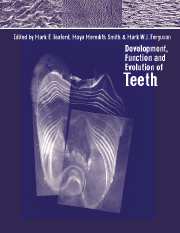Book contents
- Frontmatter
- Contents
- List of contributors
- Acknowledgements
- Part one Genes, molecules and tooth initiation
- Part two Tooth tissues: development and evolution
- Part three Evolution of tooth shape and dentition
- Part four Macrostructure and function
- 16 Developmental plasticity in the dentition of a heterodont polyphyodont fish species
- 17 Enamel microporosity and its functional implications
- 18 Pathways to functional differentiation in mammalian enamel
- 19 Trends in the evolution of molar crown types in ungulate mammals: evidence from the northern hemisphere
- 20 Function of postcanine tooth crown shape in mammals
- 21 Primate dental functional morphology revisited
- Index
20 - Function of postcanine tooth crown shape in mammals
Published online by Cambridge University Press: 11 September 2009
- Frontmatter
- Contents
- List of contributors
- Acknowledgements
- Part one Genes, molecules and tooth initiation
- Part two Tooth tissues: development and evolution
- Part three Evolution of tooth shape and dentition
- Part four Macrostructure and function
- 16 Developmental plasticity in the dentition of a heterodont polyphyodont fish species
- 17 Enamel microporosity and its functional implications
- 18 Pathways to functional differentiation in mammalian enamel
- 19 Trends in the evolution of molar crown types in ungulate mammals: evidence from the northern hemisphere
- 20 Function of postcanine tooth crown shape in mammals
- 21 Primate dental functional morphology revisited
- Index
Summary
Introduction
The postcanine tooth crowns of mammals have complex shapes adapted for mastication. Mastication is a process that reduces the particle sizes of foods. Once particle sizes are sufficiently small for saliva to bind particles together into a bolus, mastication stops and the food is swallowed. The extra food surface area exposed by particle size reduction enables a mammal to meet its high metabolic requirements by more rapid enzymic digestion than if a higher intake of large particles were more slowly digested. Mastication is an essential process if mammals are to have locomotor stamina because it allows them to be lightly built.
The repeated fracture of food particles by mastication is a mechanical process. The rate at which it takes place depends, of course, on the chewing rate of any given mammal. However, for a given chewing rate, the rate of breakdown depends on the physical characteristics of food particles, e.g. the size and shape of particles and, most particularly, on their material properties. The shapes and sizes of postcanine teeth in different mammalian species reflect adaptations to differing physical properties of foods in their diets. The tailoring of tooth form to diet allows mammals to meet their energy requirements.
For about 15 years, there has been an analysis available of mastication that allows a distinction to be made between two aspects of the process: on the one hand, the probability of food particles being fractured, and on the other, the number and size of fragments formed when any particle actually fractures.
- Type
- Chapter
- Information
- Development, Function and Evolution of Teeth , pp. 282 - 289Publisher: Cambridge University PressPrint publication year: 2000
- 30
- Cited by



